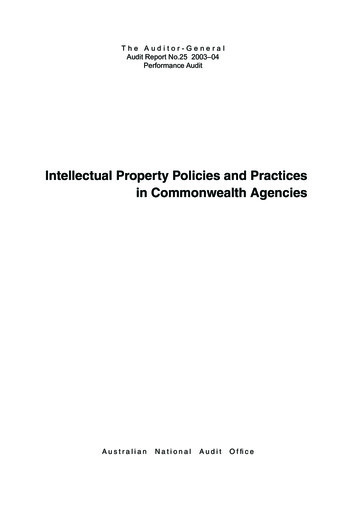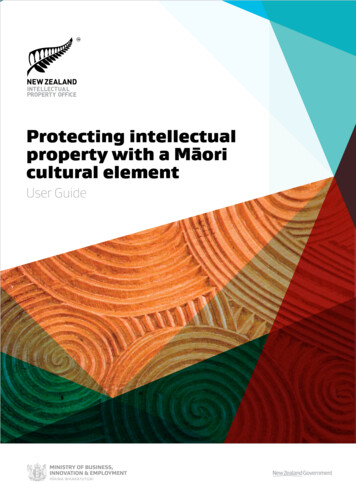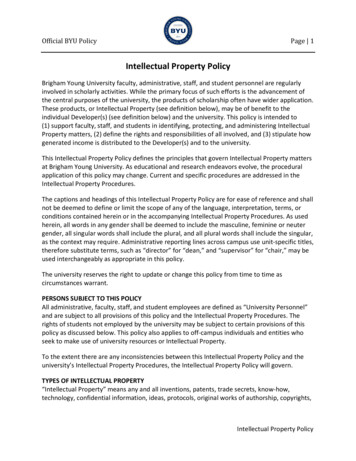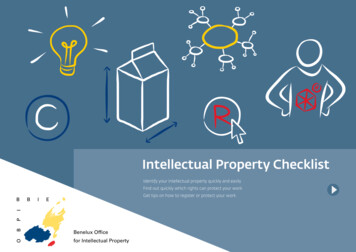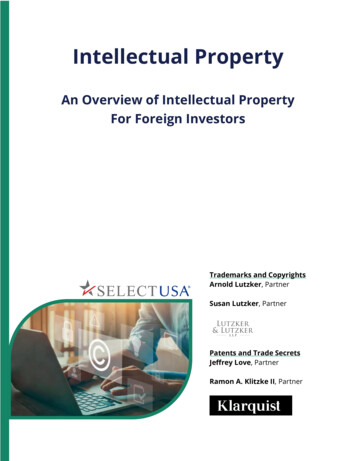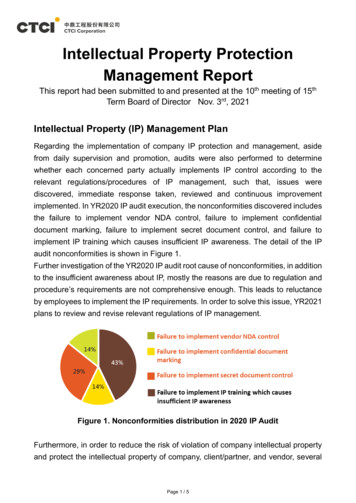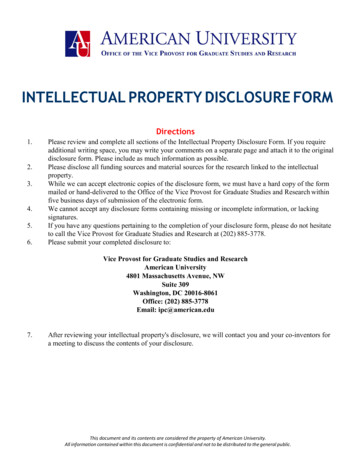
Transcription
CETA & CANADIANINTELLECTUALPROPERTY RIGHTSSupporting EU business in Canada
2CETA & CANADIAN INTELLECTUAL PROPERTY RIGHTSTable of contentsLIST OF ACRONYMS .3EXECUTIVE SUMMARY .4Quick facts about Canada .41. GENERAL INTRODUCTION TO CETA AND INTELLECTUAL PROPERTY RIGHTS .51.1. What is intellectual property? .51.2. Types of intellectual property rights .51.3. Why is knowing about intellectual property important? .51.4. CETA and intellectual property rights .51.5. Why is IP included in CETA? .61.6. Canada’s commitment to a comprehensive IP strategy .61.7. Why should EU exporters care about Canada’s IP laws? .61.8. Why is CETA important for small and medium enterprises? .62. TOP FOUR CETA-DRIVEN CHANGES TO CANADA’S INTELLECTUAL PROPERTY LAWS .83. COPYRIGHTS AND RELATED RIGHTS UNDER CETA .93.1. Articles 20.7 - 20.12 of CETA .93.2. Did you know? .103.3. Infringement, offences and enforcement .104. TRADEMARKS UNDER CETA .144.1. Articles 20.13 – 20.15 of CETA .144.2. Did you know? .144.3. Infringement, offences and enforcement .165. GEOGRAPHICAL INDICATIONS UNDER CETA .185.1. Articles 20.16 to 20.23 of CETA .185.2. Did you know? .195.3. Infringement and enforcement .206. PATENTS UNDER CETA .216.1. Articles 20.26 – 20.30 of CETA .216.2. Did you know? .216.3. Infringement and enforcement .237. INDUSTRIAL DESIGNS UNDER CETA .257.1. Articles 20.24 – 20.25 of CETA .257.2. Did you know? .257.3. Infringement and enforcement .278. PROTECTING PLANT VARIETIES UNDER CETA .288.1. Article 20.31 of CETA .288.2. Did you know? .288.3. Infringement, offences and enforcement .299. ENFORCEMENT AND BORDER MEASURES .309.1. Enforcement of IPR and border measures (Articles 20.32- 20.49 of CETA) .309.2. Border enforcement measures .309.3. Did you know? .3110. EU SUCCESS STORIES .3410.1. Arco Information NV .3410.2 Stainless-Steel Pool & Spa .35ANNEX I. EU MEMBER STATES EMBASSIES, CONSULATES AND CHAMBERS OF COMMERCE IN CANADA .36
3CETA & CANADIAN INTELLECTUAL PROPERTY RIGHTSLIST OF ACRONYMSCBSACanada Border Services AgencyCETAEU – Canada Comprehensive and Economic Trade AgreementCFIACanadian Food Inspection AgencyCIPOCanada Intellectual Property OfficeCUSMACanada-United States of America-Mexico AgreementEPOEuropean Patent OfficeEUEuropean UnionEUIPOEuropean Union Intellectual Property OfficeFITFFirst Inventor To FileGIsGeographical IndicationsISEDInnovation Science & Economic DevelopmentISPInternet Service ProviderIPICIntellectual Property Institute of CanadaPBRsPatent Breeder’s RightsPCTPatent Cooperation TreatyPMNOCPatented Medicines Notice of ComplianceRCDRegistered Community DesignTPMTechnological Protection MeasuresSMEsSmall and Medium EnterprisesRMIRights Management InformationWIPOWorld Intellectual Property Organization
CETA & CANADIAN INTELLECTUAL PROPERTY RIGHTS4EXECUTIVESUMMARYThe CETA report on Intellectual Property Rights offers an overview of the protectionof property rights under the European Union (EU) - Canada ComprehensiveEconomic and Trade Agreement (CETA).CETA is a key milestone in the EU-Canada relationship, which is widely consideredto be one of Canada’s most progressive and ambitious trade initiatives.The benefits of CETA go beyond the elimination of duties in 98% of EU-Canadatraded goods. Among others, it provides protection to EU businesses’ andprofessionals’ property rights in Canada, including copyrights, trademarks, GIs,patents, industrial designs and plant varieties.The report presents the top four CETA-driven changes to Canada’s intellectualproperty laws and offers an overview of the agreement’s mechanisms regardingprotection, infringement, offences, and enforcement in Canada. In addition, itpresents two EU success stories relating to the protection of EU businesses’intellectual property rights in Canada.Quick facts about CanadaThere are 10 provinces (Alberta, British Columbia, Manitoba, New Brunswick,Newfoundland and Labrador, Nova Scotia, Ontario, Prince Edward Island, Québec,and Saskatchewan) and 3 territories (Northwest Territories, Nunavut, andYukon) in Canada. Under Canada’s federal system, the powers of governmentare shared between the federal government and the 10 provincial governments.Canada has the tenth largest economy in the world and is one of the world’swealthiest nations. According to UN data, Canada is the world’s second largestcountry by area, with a population of 37,742,154 at mid-year 2020. It is theworld’s second largest country by total landmass, with borders on the Atlantic,Pacific and Arctic Oceans, and one of the world’s longest land borders with theUnited States (US).Figure 1. Canada’s population densitySource: Encyclopædia Britannica, Inc.Note: All dollar figures are cited in Canadian dollars unless otherwise noted. All euros figures have been converted from Canadian dollars using theInforEuro exchange rate system (June 2020).
5CETA & CANADIAN INTELLECTUAL PROPERTY RIGHTS1. GENERAL INTRODUCTIONTO CETA AND INTELLECTUALPROPERTY RIGHTS1.1. What is intellectual property?Intellectual Property refers to creations of the mind, inventions, literary and artistic works, as well as symbols, names and imagesused in commerce. It is divided into two categories, namely: (i) industrial property, which includes patents, trademarks, industrialdesigns, and geographical indications (GIs); and (ii) copyrights1.Figure 2. Terms used to describe intellectual propertya creation ofthe mindthe form anidea takesa valuableassetsomethingyou can ownsomethingyou canlicenceand/or sellsomethingyou can useto getfinancingsomethingyou can stopothers fromusingall of theprevious1.2. Types of intellectual property rightsThere are many different types of intellectual property. It is important to know what kind of intellectual property you have, so youknow how best to protect, enforce, and commercialise it.Figure 3. Types of intellectual property rightsCopyrights Trademarks ntVarieties1.3. Why is knowing about intellectual property important?In our knowledge-based, global economy, intellectual property is the competitive advantage often yielding the greatest revenuestream for businesses. Accordingly, the necessity to promote and protect these assets is self-evident. Knowing what type ofintellectual property you have, how you can use it to your advantage, and how, where, and in what circumstances you can stopothers from using it, is a key driver of business success.1.4. CETA and intellectual property rightsThe EU and Canada are among the world’s largest trading economies. The EU is the largest trading bloc in the world and the thirdlargest economy by Purchasing Power Parity (PPP). Canada is a G7 country and the 16th largest economy by PPP2. Built throughhundreds of years of shared culture and history, as well as a commitment towards liberal values, Canada and Europe’s traderelationship is robust. Since 2017, Canada and the EU share a trade agreement, the Comprehensive Economic and Trade Agreement(CETA), which eliminated pre-existing tariffs on 98% of EU-Canada trading goods.On the third anniversary of CETA coming into force, the European Commission reported that bilateral trade between EU27 and Canadahas increased by 24% for goods and 25% for services (compared to trade pre-CETA)3. The European Commission also reported that thisincrease is “much better than similar trends between the EU and the rest of the world over the same period of time”4.1 World Intellectual Property Organization (WIPO) Report on “What is Intellectual Property?”, WIPO Publication No. 450(E), available at https://www.wipo.int/edocs/pubdocs/en/wipo pub 450 2020.pdf (last accessed: 19 June 2020).2 IMF, 2020.3 EU and Canada celebrate third anniversary of comprehensive trade agreement, Brussels, 21 September 2020, id 2184&title ehensive-trade-agreement.4 ibid.
CETA & CANADIAN INTELLECTUAL PROPERTY RIGHTS6Given the importance of intellectual property for business and trade, CETA contains a chapter (Chapter 20) devoted to the issue.Chapter 20 of CETA is divided into five sections:A.B.C.D.E.General Provisions – this section identifies the general principles to be followed.Standards – this section identifies six categories of IP rights and the standards to be applied in respect of those rights.Enforcement – this section identifies principles for domestic infringement enforcement.Border Measures – this section identifies procedures to be followed to prevent the import and export of IP-infringing products; andCooperation – this section expresses a commitment to cooperate on IP-related matters covered in the chapter.Figure 4. Sections in CETA’s Chapter 20 on intellectual propertyA. General PrinciplesB. StandardsC. EnforcementD. BorderMeasuresE. Cooperation1.5. Why is IP included in CETA?Intellectual property is one of the most important and valuable assets a business may have. The degree to which a business caneffectively identify, value, and commercialise its intellectual property is material to its success. Concurrently, the degree to whicha country provides a vigorous intellectual property regime that fosters innovation, competitiveness, and creativity, is crucial to thatcountry’s success and that of its businesses.In recognition of this, CETA’s stated objective in respect of intellectual property rights is expressed as follows:-To facilitate the production and commercialisation of innovative and creative products, and the provision of servicesbetween Canada and the EU; and-To achieve an adequate and effective level of protection and enforcement of intellectual property rights5.1.6. Canada’s commitment to a comprehensive IP strategyIn June 2018, the Government of Canada announced a 5-year plan to invest 56.28 million ( 85.3 million) in a comprehensiveIntellectual Property Strategy6. The strategy includes assisting Canadians and other users of Canada’s intellectual property systemin identifying, protecting, and enforcing their intellectual property rights at a level that is generally consistent with internationalintellectual property treaties and standards. This strategy includes highlighting the benefits of CETA to encourage EU innovators,creators, and businesses to take advantage of the agreement.1.7. Why should EU exporters care about Canada’s IP laws?CETA has incentivised EU exporters to pursue their scientific, creative, and business endeavours in Canada, by among other things,ensuring that they can access and evaluate the Canadian IP landscape and make informed decisions respecting maintenance,use, commercialisation, and enforcement of their intellectual property in Canada. Understanding Canada’s domestic IP landscapeensures that EU exporters entering the Canadian market can do so confidently, with eyes wide open.1.8. Why is CETA important for small and medium enterprises?CETA provides EU businesses with greater access to opportunities in Canada (and vice-versa), and greater predictability, transparency,and protection for their investments in Canada. It ensures that EU businesses that export goods or services to Canada can maintain,protect, and enforce their intellectual property rights at a level that is generally consistent with their respective, domestic, or collectiveEU experience.EU businesses of all varieties and sizes have been taking advantage of CETA to enter the Canadian market and leverage opportunities.In some cases, when goods are considered to have Canadian origin, they can also export to the US on a duty-free basis under theCanada-United States-Mexico Agreement (CUSMA).5 CETA, Chapter 20, Section A, Article 20.1.6 Intellectual Property Strategy, from ISED: ordion-item-3.
7CETA & CANADIAN INTELLECTUAL PROPERTY RIGHTSAccording to the 2019 IP Canada Report, “businesses that have a higher awareness of IP, along with those that hold formal IP, aremuch more likely to experience higher growth, expand their markets, and receive various types of financing”7. In addition, the 2019IP Canada Report found that SMEs holding formal intellectual property are 4.3 times more likely to have expanded internationally,and 5.4 times more likely to plan to expand internationally.Figure 5. Market-expansion trends based on awareness and use of formal IP and market expansion8Plans to expand internationally5.43.4Plans to expand domestically3.82.6Has expanded internationally4.32.4Has expanded domestically31.901SMEs holding formal IP23456SMEs aware of IP7 The 2019 IP Canada Report, prepared by the Government of Canada, Department of Innovations, Science and Economic Development, at page netopic.nsf/vwapj/IP Canada Report 2019 eng.pdf/ file/IP Canada Report 2019 eng.pdf.8 Supra, page 34.
CETA & CANADIAN INTELLECTUAL PROPERTY RIGHTS82. TOP FOUR CETA-DRIVENCHANGES TO CANADA’SINTELLECTUAL PROPERTY LAWSTrademarks – Based in part on Canada’s commitment to CETA, on 17 June 2019, Canada brought into force the Madrid Protocol,the Singapore Treaty, and the Nice Agreement, each of which contributed to a significant and substantive change to trademarklaw in Canada.Geographical indications (GIs) – protected GIs are now extended beyond wine and spirits to include distinct agricultural and foodbased products. Canadian producers are not allowed to sell local or foreign products as European geographical indications if theyare not.Patents and regulatory data protection – the term of pharmaceutical patent protection is extended by up to 2 years to complywith Canada’s commitment to CETA to provide a period of sui generis protection. Also, based on Canada’s commitment to CETA toprovide innovators and generics with an ‘equivalent and effective right of appeal’ when patent linkage systems are in place, Canadanow provides equal rights and no longer maintains a dual track system.IPR border enforcement – Canada’s intellectual property rights border enforcement regime was the subject of extensive changein anticipation of the implementation of CETA. The definition of protected marks covered by Canada’s intellectual property rightsborder enforcement regime was expanded by CETA and now includes geographical indications.
9CETA & CANADIAN INTELLECTUAL PROPERTY RIGHTS3. COPYRIGHTS AND RELATEDRIGHTS UNDER CETA3.1. Articles 20.7 - 20.12 of CETAThe copyright provisions of CETA (Article 20.7 – 20.12) obligate the parties to comply with established standards set out in variousinternational agreements, including the Berne Convention for the Protection of Literary and Artistic Works, WIPO Copyright Treaty,WIPO Performances and Phonograms Treaty, and the Rome Convention for the Protection of Performers, Producers of Phonogramsand Broadcasting Organizations.The Copyright Modernization Act, S.C. 2012, c.20, an Act to amend the Copyright Act, RSC 1985, c. C-42, was assented to on 29 June2012, and it brought Canada’s copyright legislation in line with each of these international agreements. Consequently, CETA had noappreciable change to Canada’s own copyright legislation. Rather, the function of the agreement is to shape copyright cooperationbetween Canada and the EU.The copyright provisions of CETA also define what constitutes adequate legal protection and/or effective legal remedies (i.e.,enumerated minimum standards) in 5 broad categories:1.2.3.4.5.Broadcasting and communication to the public (Article 20.8);Protection of technological measures (Article 20.9);Protection of rights management information (Article 20.10);Liability of intermediary service providers (Article 20.11);Camcording (Article 20.12).Each of these 5 obligations will be discussed in more detail below.BENEFITCanada’s commitment to numerous international copyright treaties provides assurance to EU artists and businesses that theircopyright and related rights will be protected and enforced to maximise their ability to monetise those rights. In addition, itprovides a mechanism for enforcement of those rights, which is consistent with international standards.Table 1. A quick comparison between some aspects of EU and Canadian copyrightEU COPYRIGHTTermLife of author plus 70 yearsCANADIAN COPYRIGHTLife of author plus 50 years**CUSMA9 requires Canada to increase theterm of protection to life of author plus 70years for works.Type of Registration and/orApplicationNo formal registration is required.No formal registration is required.Copyright protection begins upon creation ofthe work.Copyright protection begins upon creation ofthe work.IPR Border EnforcementAvailableAvailableOnline Infringing ActsNotice and Take DownNotice and NoticeE-Commerce Directive 2000 requires thatonline hosts expeditiously remove or disableaccess to the content they host when theyare notified of the alleged illegality.Copyright Act specifies that notice must begiven by the ISP to the alleged infringer, butthe law does not require the ISP to disable orremove access.The ISP is required to retain records that willallow the identity of the person to whom theelectronic location belongs to be determined for6 months.9 CUSMA entered into force on July 1, 2020. Changes to the Copyright Act to extend the term of protection must be made within 2.5 years of cominginto force of CUSMA.
CETA & CANADIAN INTELLECTUAL PROPERTY RIGHTS103.2. Did you know?What is a copyright in Canada? A bundle of rights that protect original, literary, artistic, dramatic, and musical works. Copyright provides the exclusive right to reproduce the work that the copyright is meant to protect. It also includes the right to publish a work, translate it, or perform it. Copyright exists automatically when the original work is created, formal registration is not required.Indicating copyright : Marking a work with the copyright symbol [ year, author] is not mandatory, but because it is wellrecognised, it is recommended.Registration of copyright: Registration is available and helpful but not required. Registration establishes a rebuttable presumptionof subsistence and ownership i.e., that copyright exists, and that it is owned by the registrant.Database of registered copyrights: CIPO maintains an on-line database of registered copyrights10.Applications for copyright registration: Application can be done online and is inexpensive 33 ( 50.00), if submitted online11.No deposit of copyrighted work is required, and there is no substantial review prior to registration.Term of protection for copyright: The basic term of copyright protection in a work is life of author plus 50 years, but that ischanging. CUSMA requires that Canada amend the Copyright Act to increase the length of copyright protection for works to life plus70 years, and for performances to life plus 75 years.Authorship of works & ownership of works & works made for hire Authorship and ownership can be different. Authorship must be an individual, not a corporation. When works are created in the course of employment, absent an agreement to the contrary, the first ownership incopyright will be given to the employer. When works are created outside the employer/employee context, for example by a consultant or independent contractor,the author retains ownership unless there is an assignment, in writing, signed by the author or their representative.Moral rights: Canada recognises moral rights of attribution, integrity, and association for authors and performers. Moral rights maynot be assigned or licensed but may be waived in whole or in part.Neighbouring rights: Canada recognises rights that protect the legal interest of performers, sound recording makers, and broadcasters.Fair dealing: Canada recognises a fair dealing exemption for copyright infringement, which is limited to research, private study,education, parody, satire, criticism, review, and news reporting.Assignments and licences: Assignments and licences may be registered with the copyright office.3.3. Infringement, offences and enforcementInfringement: Infringement arises when someone exercises a right only available to the copyright owner without the owner’sconsent. There are two kinds of copyright infringement: Direct infringement – for example, when one reproduces the copyrighted work without the consent of the owner. In thatcase, liability will arise whether or not the infringer knew that the work being infringed was subject to copyright; and Indirect infringement - this arises in respect of activities like selling, renting, distributing, importing, and exporting worksthat are subject to copyright protection without consent of the owner. In the case of indirect infringement, liability will onlyarise if the infringer knew that the copyright was being infringed.The standard of proof in the civil context is a balance of probabilities.10 To search the Copyright Database go to: ch.do?lang eng&wt src cipo-cpyrght-main&wt cxt toptask.11 Registration of Copyright -CIPO- link to file online: topic.nsf/eng/wr03915.html?Open&wt src cipo-cpyrght-main&wt cxt toptask.
11CETA & CANADIAN INTELLECTUAL PROPERTY RIGHTSWho can sue? The owner of the copyright or the owner of a moral right, and any person deriving any right, title, or interest fromthe owner by assignment or a grant in writing (except for moral rights); and an exclusive licensee can sue in their own name forcopyright infringement.Limitation periods: The law imposes deadlines on when an action must be started. It is always important to act quickly and seekthe advice of a licensed Canadian lawyer to ensure compliance.What Court has jurisdiction: The Federal Courts of Canada and the provincial superior courts have concurrent jurisdiction for mostintellectual property disputes, but only the Federal Court has jurisdiction to impeach, invalidate or expunge intellectual property12.Most copyright cases are heard before the Federal Courts of Canada.Remedies may include:A successful plaintiff in a copyright action is entitled to damages and
7 CETA & CANADIAN INTELLECTUAL PROPERTY RIGHTS According to the 2019 IP Canada Report, "businesses that have a higher awareness of IP, along with those that hold formal IP, are much more likely to experience higher growth, expand their markets, and receive various types of financing"7 In addition, the 2019 IP Canada Report found that SMEs holding formal intellectual property are 4 3 times .
